#minnesingers
Text

Wolfram von Eschenbach and his Squire (Codex Manesse)
#wolfram von eschenbach#knight#squire#art#codex manesse#german#medieval#middle ages#knights#squires#chivalry#europe#history#european#heraldry#coat of arms#poet#poetry#minnesingers#minnesang#minnesinger#minnesänger#helmet#helmets#jousting
146 notes
·
View notes
Text
PREMIUM A1 PUSSY WETS FAT DICK INSTANTLY💦🐳
German MILF Pov teased Blowjob Handjob for Young Guy
سكس راجل عربي مسلم
She loves Anal destruction and squirting Pietra Analslut
Blowjob Bet Pays Off
Petite teens pussy licked
Young teen amoy
Sky Blu black woman used by white jerks
Having fun Doggy Style
Redheaded teen pounded
#self-perfect#trips#sideslipped#ensuance#successmindset#Tentaculites#fiascoes#silver-golden#middle-class#ecardine#ordn#jarls#antireactionaries#superinnocently#preregulate#natraj#shinneys#declare#minnesingers#prepotently
0 notes
Text
The Sultan, they said, was a good man. Soft, quickly moved to tears. Out of compassion, he bought the freedom of a Christian woman's stolen daughter. Even Walther von der Vogelweide, the minnesinger in distant Germany, praised the "mildness" of the powerful ruler in the Orient, whose name has a good reputation in the West: Saladin, a righteous man.
He was a man who always kept his word, even to his enemies.
He let his subjects drag him to court, because God's laws applied equally to everyone. Also for him, the ruler who managed to do what no one had ever managed before: to unite the Islamic world of the Middle East after centuries of discord and to wrest Jerusalem, the holy city of the Muslims, from the Christians in 1187.
His name translates as "righteousness of faith", and Saladin is indeed a devout Muslim. Nevertheless, after his conquest of the Holy Land, he allowed the Christians and Jews there to continue praying to their God. This is another reason why, more than half a millennium later, Western Enlightenment thinkers would make him the epitome of the tolerant ruler.
But this al-Malik an-Nasir Salah ad-Din Abu'l-Muzaffer Yusuf ibn Ayyub ibn Shadi, known as Saladin for short, also had other sides.
He could be treacherous, vile and mean. He did not shy away from murder. Nevertheless, this man fascinated his contemporaries. He became one of the most revered rulers of the Islamic world and the most important opponent of the Crusaders.
Saladin was born in 1138 in Tikrit (in present-day Iraq), the son of a Kurdish officer. During his political career, Saladin was the first to bring Egypt's army under his control.
Saladin, a Sunni, now founds two universities where theology is taught according to Sunni theology - a signal that he is on the side of the population. He also abolished a number of taxes that contradicted the Koran and the teachings of the Prophet.
Saladin's subsequent conquests shock the Christian world. By 1174, his power extended from North Africa to the southern tip of the Arabian Peninsula. In 1186, he ruled from the Nile to the Tigris.
At the height of his power, the Sultan even dreamed of taking the Holy War to Europe, conquering Rome - and putting the Pope in chains.
The Crusaders conquered Jerusalem in 1099 and held it until Saladin besieged it in 1187 and handed it over to the Ayyubid dynasty, a Muslim sultanate that ruled the Middle East at the beginning of the 12th century.
Saladin wanted to recapture the city, which had previously been ruled by Muslims.
For Muslims, Jerusalem is a place where important events in the life of Jesus and other important personalities took place. It is also the place where the Prophet Mohammed ascended to heaven according to the traditional interpretation of the Koran and other texts.
In Sunni Islam, Jerusalem is the third holiest city after Mecca and Medina. Muslims believe that Muhammad was brought to Jerusalem during his night journey (Isra and Mi'raj).
The name Jesus is mentioned twenty-five times in the Holy Qur'an, often in the form 'Isa ibn Maryam, which means "Jesus, son of Mary". In the Quran, he is given the unique title "Messiah" (al-masih in Arabic), which means "anointed one". He is considered one of many prophets from the lineage of the Prophet Ibrahim, or Abraham (peace be upon him). Many Muslim traditions regard it as an ideal example of spirituality. Unlike Christians, who generally believe in a triune God, Muslims believe that Jesus was a great prophet who was to lead mankind on the straight path of monotheism and obedience to God (Allah).
When Jerusalem also fell, two kings and an emperor set off for the Holy Land with their armies from 1189 onwards. One of the monarchs is King Richard I of England. Even before the armed pilgrimage, he had already earned himself an honourable name: "Lionheart."
Saladin lies in wait for the Christians in the forests of Arsuf near the Mediterranean coast. But King Richard of England had anticipated the attack; on 7 September 1191, his troops won a clear victory. Nevertheless, the Muslim army is still strong enough to block the road to Jerusalem.
Saladin's reconquest of Jerusalem in 1187 prompted Pope Gregory VIII to organize the Third Crusade. From 1189 to 1192, Saladin lost Acre and Jaffa and was defeated in the field at Arsūf. The Crusaders retreated to Europe without seizing Jerusalem, but Saladin's military reputation had been damaged. He died in 1193.
#learn about history#studyblr#religion#religious studies#crusaders#history#oriental#history of crusade#Saladin#king baldwin iv#kingdom of heaven#history of Jerusalem#Islam#christianity#history of Religion#teaching#books#booklr
69 notes
·
View notes
Text

Next chapter is up! Thanks @mistresslrigtar for looking it over!
Summary: Two lives meant to be lived in parallel, forbidden to intersect. Two souls longing for each other, against every rule. Two hearts, lonely in a castle stuffed with people.
One delicate secret.
Rating: Explicit (barely, but still). Chapters: 2/3. Words: 1818
Crown of Lies, chapter 2
Link's gaze swept over the banquet in front of him, swiftly ignoring the tables bending under the weight of delicious food. He had long overcome the appetite that kindled in him whenever he stood guard and the hearty scent of a roasted boar or other delicacy tempted him. It wasn't his place to eat with royalty and nobility and never would be, Hero or not.
His routine sweep left him somewhat satisfied. The nobles played their usual dirty game of politics and gossip, some of them bathing in their self-proclaimed importance, others scrambling for attention. His new king, Lord Brat, as Link still called him, hung on the lips of his favorite minnesinger on the other side of the long table. Zelda, placed directly in front of Link, held her ground in a discussion about the infrastructure strategy paper she had introduced to the council this morning with some lady whose eyebrows were raised to her hairline.
No, the one who put Link on edge was Lord Asshat, as he called him; the guy who believed himself to be smooth and was nothing but slimy.
9 notes
·
View notes
Note
Hey, just saw your post about Egal the Bard or whatever his name is having inaccurate instruments and making inaccurate music. Your info was very helpful about the instruments, but could you please speak more to why it's musically inaccurate? Or maybe, do you have video examples of what traditional medieval ensemble music sounds like?
Thank you for asking! I run this blog to share things with the intellectually curious.
The misrepresentation of historical music is my pet peeve. I was not kind to this burnout bard, this short-shift schop, this miniature Minnesinger, because he is making the work of medievalists harder. I don't care if someone wants to play bard, but they shouldn't advertise their modern pop stylings as having been informed by the sonic architecture of the middle ages.
Here's the lowdown on medieval European instrumental music:
A lot of it came from North Africa and the Middle East. The Maghrebi Arab-Berbers, whom the Europeans called the Moors, conquered Andalusia and added it to the Umayyad Empire, which was huge and was comprised of Arabs, Persians, Turks, formerly-Byzantine Christians, and Jews. They brought instruments like the lute and shawm with them, and these instruments subsequently spread across Europe. The Moors brought a lot of culture to Europe in general: Córdoba became the European center of learning, especially in math, astronomy, medicine, and philosophy. The three Abrahamic faiths coexisted peacefully (well, after the invasion, and until the Christian Reconquista and subsequent expulsion of the Jews). Arabic, Persian, and Syriac cultures had also preserved classical Greek writings, and as Europeans returned from their various Crusades, they brought this knowledge with them. Aristotle inspired the monastic, literate intellectual life of medieval Europe, and Plato, via Arabic transmission, later inspired the Italian Renaissance.
We don't know how medieval instrumental music sounded, as we have no recordings and very few surviving instruments, and because most of the music and music theory that was written down was sacred a capella music recorded by literate monks and nuns. Secular instrumental music was seen as a baser art, although that was the opinion of the monastic intellectuals, whose perspective is the only one that survives in writ. History is written by the ruling classes.
We can gather clues by looking at medieval depictions of instrumentalists. Illustrations are often simple and stylized, and historicist luthiers' recreations based solely on iconography tend to be cartoony and rough (like anime cosplay!). They should be relegated to theatre props. However, iconographic evidence may be augmented with the study of surviving "folk" music traditions (pardon the classist label. All music is folk music because all music is made by folks!). Some European folk instruments are very old and have evidently changed very little over the centuries, and many of their Middle Eastern and North African progenitors are still played, and the artistry of the great instruments like the oud (lute) and qanoun (psaltery) has been cultivated to greater depths than were ever reached in Europe, because their roots are so much older. The European genius is just as brilliant, but fickle: it often discards its old tools for new ones. For instance, the barbat, the Central Asian/Greater Iranian lute, has been played since ancient Mesopotamian times, and its descendents are more popular today than ever before.
Unfortunately, the Anglophone medieval European academic scene is still overcoming its inherited Eurocentrism, and Arabic scholarship is largely inaccessible to us due to language barriers. I'm sure everything is thoroughly documented and annotated in Arabic scholarship...
If we want to imagine what medieval Al'Andalus sounded like, our best bet is to listen to traditional Andalusian ensembles. The Arab-Andalusian Orchestra of Fez is over a century old - the oldest Andalusian ensemble that is still active - and its repertoire goes back to the middle ages:
youtube
Note the melodic intervals sound European, not Arabic. The ensemble prides itself on this. European tuning theory has changed subtly over the centuries, but from its earliest Greek roots it is still recognizable to the modern western ear. Traditional Andalusi music is similarly familiar, though Arabic, Persian, and Turkish music sound microtonally exotic to unaccustomed ears.
We have a treasure, a 13th century Galician illuminated songbook from the court of Alfonso X, el Sabio, of Castile. It's called the Cantigas de Santa Maria and it is full of sacred and pseudo-sacred Marian poems with notated melodies and illustrations of musicians.
Here are scenes from the musical life of Alfonso's court:








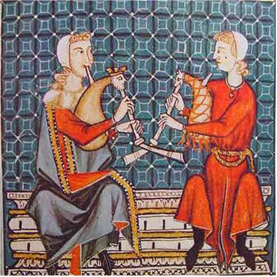

Here is a leading European early music ensemble's imagining of how it MAY HAVE sounded:
youtube
Here is another glimpse of the past, the painted ceiling of the Capella Palatina of Palermo, Sicily, Fatimid in style, from the 12th century. There are a lot of images of musicians on the six pages of this website.
In short, one mustn't take recordings of recreations of medieval music as gospel. Musicologists, music historians, and historical performers like myself do as best to be as authentic as we can, but the further we look back in history, the more we must engage in creative guesswork. It can be seen as artistic collaboration across time.
"The past is a foreign country."
- L.P. Hartley
13 notes
·
View notes
Text
#unhallowedarts The Tale Of Lohengrin, Wagner and the Golden Age of Illustration

“Aye , quick it is with the seeds of
change
With blessing and with bane.
But I deem it a thousand years shall run
Or ever beneath the open sun Thy voice shall sound again”
(T.W. Rolleston)
It was a knight in shining armour all right, albeit not white-steeded but pulled up the river Scheldt by a white swan, to save Elsa, ubiquitous damsel in distress, from dark Count Telramund’s cabal to usurp the Duchy of Brabant. In trial by combat, goes without saying, as it was the custom back in the days of King Henry the Fowler, which were at the turn of the 10th century when the place was part of the East-Frankish kingdom of Austrasia. Or so Richard Wagner would have it in his usually somewhat giddy take on Medieval epics and historical events. The valiant’s name, however, was Lohengrin, the one from Lothringen, Lorraine, obfuscating the man’s true origins: Lohengrin hailed from the grail castle Monsalvat, Wagner’s scene for “Parsifal” thirty years after “Lohengrin” premiered in Weimar in 1850.

Lohengrin’s mystical provenance is one of the arch-Romantic opera’s central motifs and, of course, the Germans have a word for it, “Frageverbot”, the forbidden question after the man’s origins, checking at least two of the “tall, dark, stranger” three boxes. Lohengrin is a luminous figure, but a rather sad one and the story ends in tears when the hero sails, swan-propelled, into the sunset after his work is done. Bitter, but Wagner and the zeitgeist wouldn’t have it any other way.
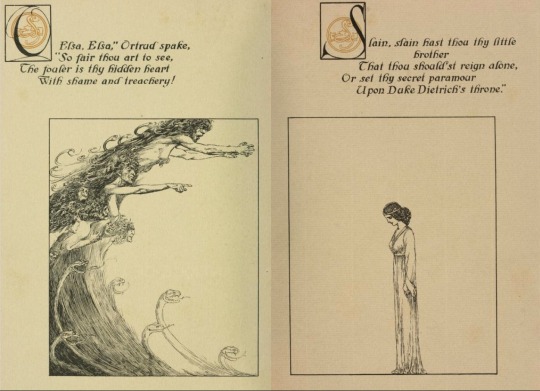
The tale of Lohengrin itself hails back to the High Middle Ages, honourably mentioned by Wolfram von Eschenbach in the early 13th century as Garin le Loherain in the minnesinger's “Parsifal”, gets two own contemporary verse epics and several variants of the swan knight theme over the next centuries until Wagner collected them all and crammed the rich material into his three hour opera, along with heroics from antiquity, elements that were perceived as Germanic paganism in the rather clouded view of the 19th century on Iron Age customs and beliefs and politics of Wagner’s own day when the Germans fought for their national unity. Along with romanticised Christian mysticism. Lohengrin is a grail knight, after all. And they do get properly married, Elsa and Lohengrin, to the sounds of “Here Comes the Bride”, no less, faithfully guided, “Treulich geführt” in Wagner’s original German from the opera’s libretto, a tune heard at the fabled joyous event across the globe ever since a Prussian royal wedding in 1858.

Wirkmächtig, efficacious, and if only for said tune, even if the topic borrowed from the old tale of Zeus and Semele, the metaphysic being hiding its true identity because the partner-to-be, as the saying goes, “can’t handle the truth” should raise every imaginable red flag, Romantic mystery or not. Even if Lohengrin reveals his true identity in the end, before his picturesque exeunt when the king calls to arms to make war against the pagan marauding Hungarians down South.

On that note, it is not without irony that Willy Pogany, born in 1882 in the back-then Austro-Hungarian city of Szeged, illustrated the tale of Wagner’s “Lohengrin” for Rolleston’s retelling with rich imagery that equals that of the better known Arthur Rackham’s of the “Ring” trilogy published around the same time. Pogany’s “Lohengrin” hit the booksellers’ shelves in 1911, along with “Parsifal” and “Tannhäuser”, when precious “gift books”, illuminated by the luminaries of the Golden Age of Illustration, were still all the rage as Christmas presents in a time when “education” was a hallmark of what passed as “better classes” back in the day.
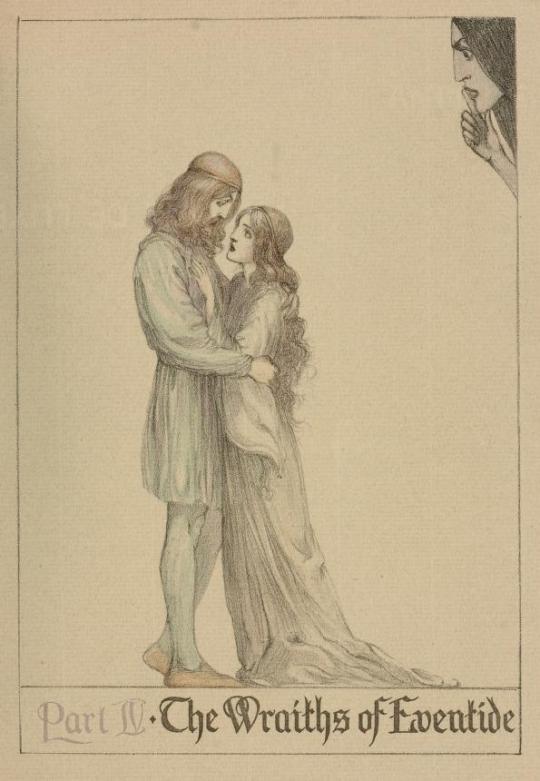
Pogany, pronounced PO-gahn, immigrated to the US before the Great War turned the world upside down in Europe, after getting properly married in London, revealing his true identity from the very beginning, goes without saying. He continued to illustrate mainly children’s books and stuck to his Art Nouveau-influenced style that sometimes reminds of Edmund Dulac, albeit with stronger lines and expressions than the Anglo-French better-known master would come up with in his dreamy takes on often the same themes as Pogany took on.

T.W. Rolleston retelling of Wagner's "Lohengrin" along with all of Willy Pogany's enchanting (and often quite dark) illustrations can be cherished following the link to a facsimile below:
#unhallowedarts#dark art#dark aesthetic#dark academia#bookart#dark acadamia aesthetic#golden age of illustration#art nouveau
36 notes
·
View notes
Text

Rafael Krieger
Age: 580 (Turned at 32)
Gender: Cis Male
Sexuality: bisexual/pansexual (he really doesn’t care for labels tbh)
Nationality: Austrian
Race: Vampire (formerly human)
Appearance: Tall, weathered skin, long ginger/ blond hair, well groomed beard, bright blue eyes, handsome features, strong build, bright smile, several tattoos and piercings.
FC: Ben Metzner
Personality: Jovial, wise, observant, curious, loves to entertain others, lively, natural leader, friendly, mostly forgiving, generous, slow to anger, enjoys a good fight, protective, considers friends and/or coven members to be his family, restless at times, longs to see the sun again, swashbuckler at heart, strong sense of justice and loyalty, will always help outcasts when and where he can.
Powers/Abilities: hypnotic gaze, silver tongue, shapeshifting (bat, wolf, or mist), superhuman speed/agility/strength, telepathy, vampiric bite, immortality, eternal youth, can scale vertical surfaces and ceilings without being affected by gravity, adept swordfighter, plays the lute, flute, and bagpipes, sings brilliantly.
Weaknesses: Holy water, crosses and other non-satanic holy symbols, running water, sunlight, fire, stake to the heart, cannot enter someone’s residence without invitation, must feed on human blood at least once every few nights (he can sustain himself on animal blood, but must do so far more often), not very studious (though he can read multiple languages), bad at math.
Languages: German, English, French, Romanian, Russian, Hungarian, Latin, Italian, Portuguese, Spanish.
Style: Sort of a blend of pirate, carnival barker, and punk rock star. Lots of leather and fringe, flowing shirts, tight but breathable pants, pirate boots, either neutrals or loud patterns, lots of rings, always wears wrist cuffs and bracelets, multiple belts.
Profession: Minnesinger (while human, essentially a traveling entertainer), Carnival Barker (former, multiple times), Musician (former), Mercenary (while human)
Family: none (orphaned as a baby)
Backstory: Rafael grew up in an orphanage in the mid-1400’s. From a young age, he was well known amongst his peers for being a born entertainer, always coming up with wild stories and singing songs of great battles. At fourteen, he decided to appease his restless heart by taking his talents to the streets to try and earn some money. Traveling from village to village, he made quite a name for himself. People would always toss him a spare coin or two when they heard him play, if they had it, and by the time he was twenty, he could afford most any comfortable accommodations. Life was good!
Or so he thought. The more he traveled, however, the more he saw how naïve he’d been. In the villages closer to the border, poverty and corruption and lawlessness were far more evident, and only made worse by sporadic raids from Ottoman invaders. Rafael found himself called to learn how to wield a sword and shield just as expertly as he wielded his silver tongue. His sense of justice prompted him to train day in and day out, which payed off when the time finally came for him to fend off his first real adversary: a city guard with a penchant for abusing power in various ways. The guard took offense to one of his songs and challenged him to a duel, only for Rafael to defeat him soundly, proving his natural talent with a blade. From there, his skills only improved, but the dangers he faced also increased exponentially. He kept traveling, fighting in more battles against raiding parties and marauders than he could keep count of, defending civilians and nobles alike to the best of his abilities.
(Not finished, but I’m publishing now before I forget. I’ll add more later)
#🦇 goth chic 🦇 aesthetic#🦇 chaos behind the quill 🦇 ooc talk#🦇 calling all the monsters 🦇 promo#🦇 developing characters for fun and chaos 🦇 headcanon#🎪 shine bright circus man 🎪 c; Rafael
5 notes
·
View notes
Text


THE GREAT WAR AGAINST THE WITCHES, THE BATTLE OF THE KHANGAI MOUNTAINS. For @MYTHVOICED ⬩ 07 OCTOBER 1845
"Well, well, well. Isn't it She with her little bow."
Her tone is condescending, her eyes, inhabited with fires from a thousand hells. The lamia is standing, strong, proud, at the top of the Hill of Sihege in the Valley in the east in Mongolia. Miles down her hill, the battle was still exploding, the swords, the spells of her soul eating creatures, her army of vampires and ghouls destroying, eating, exterminating under her command, following her anger like a prayer, worshipping it. She is the heart of the war, the core of this rage, the mind behind this insanity that have spread across the realms for fifty years already. Calixtus Orion. A name that was spoken, whispered in fear and hate as the creature was decimating both the World of the mortals and the Underworld. She had to be stopped, put down, judged and executed in order for the Worlds not to reach that point of non return Calista was, step by step, approaching. It was the reason why the Order of the Knights was sent, to chain her down. And oh, how amusing it was to the undefeated Queen of the Night. The leaves of the trees were chanting in a sky that was darkened with blood and doors wide opened on Hell. And the screams, and the fires were only fulling Calita's passion and insanity. In front of her, that archer again, The Huntress. It was their second time facing each other in this canvas of terror. A wind made of desolation and ashes was blowing as Calista's white hair tainted with the blood of her enemies was floating under the rising moon."I cannot have One massacre for myself, now can I? You and your little troup of minnesingers have already lost against me and my ghouls. What do you want then, you Irrational Little Being? Another round of my blood spilled against your skin? Oh...? " Her head mechanically bend to the side, like a robotic doll from a cursed heaven on a background of flames, her pupils sparkling in madness in the anticipation of fighting the Knight again.
"HAHAHAHAHAHA.
IS THAT WHAT YOU WANT? FOR ME TO DESTROY YOUR BODY AND SOUL BACK INTO MORTALITY HUH?"
The lamia shouts, her eyes widening in mania as her dark blood is pumping through her veins. If it was infuriating, for the Order to constantly come and ruin her battles, she however knew they would send their most talented soldier to face her, over and over, again and again until Calista teaches her the right lesson. Their first battle have been a revigoration for the lamia, one that however ended in a tie in between her and the Huntress, both immortals enable to die under each other's sword. An inconvenience Calista was willing to work on to change.
"You do have talent, Archer. A Wasted talent, being on the wrong side of History, don't you think? If your wish is to perish under my sword however, it's nothing I will ever go against. Mmmm I've never been so hungry Ohhh I will eat you alive." The lamia then adds, deranged eyes fixating her prey, her tongue sticking out, licking over her fangs like the beast she is.
Speed. The lamia was a beast indeed, of both cruelty and elegance, and speed was one of her many abilities. In two steps, she runs through the grass and the dirt, her frame like a sharp blade cutting through the air, the fabrics of her Commandant apparel made of black and red velvet is floating around her limbs. Like a manic dancer, her hand extends as she spread her fingers and her palms firmly wrap around the handle of a sword that takes shape out of her own shadow. Acerola. Her legendary blade made of gold and forged in Hephaestus fires that becomes the lamia's arm extension. And she slams it, at full force, at full speed against the Huntress's blade. Their faces, only separated by a inch now, the lamia's red and golden eyes linking with the other's, eyes of thirst for blood and power, eyes filled with unstability and yet fascination for the only being who made it far enough to get a taste of her blood. "Tell me you missed me." She whispers in a deranged tone, her teeth greeted, pressed into a wide grin before shouting.
"SHOW ME YOUR HUNGER!"
#셋 𝐂𝐀𝐋𝐈𝐒𝐓𝐀 / the immortal.#셋 𝐂𝐀𝐋𝐈𝐒𝐓𝐀 / interactions.#𝒇𝒊𝒏𝒊𝒔𝒉 𝒎𝒆 𝒐𝒇𝒇 𝒊 𝒄𝒂𝒏'𝒕 𝒃𝒆𝒂𝒓 𝒕𝒐 𝒔𝒆𝒆 𝒚𝒐𝒖 𝒔𝒖𝒇𝒇𝒆𝒓. ── calista & sarang.#:)#Now kiss
2 notes
·
View notes
Text
Y'all better get ready for historical troubadour/Minnesinger Eskel, set in Germany around 1100/1200; maybe even a version of him in 1400/1500.
I need a thread with him and Jaskier have an epic standoff at the famous Singer's War of Wartburg. It would be awesome.
We could have Eskel shag his way through the Lords and Ladies at English, French or German castles...snowed in with a bunch of horny widows...
Some gimme? Please?
4 notes
·
View notes
Text
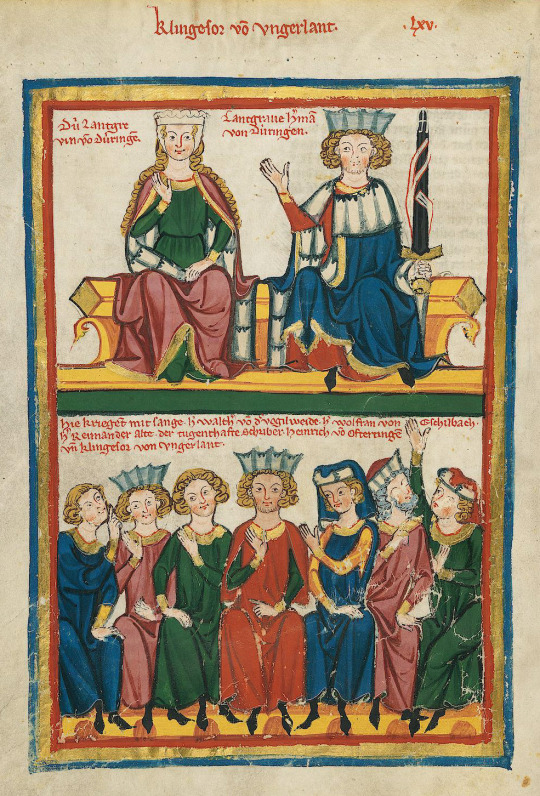
Heinrich von Ofterdingen is a fabled, quasi-fictional Middle High German lyric poet and Minnesinger mentioned in the 13th-century epic of the Sängerkrieg (minstrel contest) on the Wartburg. The legend was revived by Novalis in his eponymous fragmentary novel written in 1800.
“The spiritual worlds is in fact already open to us.
It is always open.
If we were to suddenly become so alive and supple to perceive it,
We would perceive ourselves in the midst of the spiritual world.”
Novalis
#novalis#georg philipp friedrich von hardenberg#heinrich von ofterdingen#german romanticism#fairytale#fairy tales#classic literature#german literature#fantasy#books#reading#books and reading#quotes#booklr#bookish#booksbooksbooks#literary quotes#literature quotes#book community#bibliophile#quote of the day#books and libraries#lit#book recommendations#book recs#book list#book reccs#reading list#literature#classic books
1 note
·
View note
Text
To all of which our hero, strutting very heroic and confidential and like a warbling Minnesinger beside the beautiful, expensive woman, along the twilight road, replied in extenso, giving his reasons and his ideas and his deductions, and all he thought upon the matter, all he had thought in the past, all he would think in the future, and he sounded very sweet, a soul of honey and fine steel, of course.
D.H. Lawrence, Mr. Noon
0 notes
Text

The Singers' Quarrel at Wartburg Castle by August von Wille
#august von wille#art#wartburg castle#medieval#middle ages#germany#minnesang#minnesinger#german#thuringia#courtly love#knights#history#minnesänger#eisenach#castles#castle#war of the wartburg#chivalry#chivalric romance#european#europe#singers#poets#singer#singing#knight#romantic#song#songs
123 notes
·
View notes
Text
Beatniks medievales: la sátira en verso
Aquel melenudo trashumante que veíamos remontar las calles con la guitarra a cuestas, ladeado en la entrada de un almacén o sobre el capot de un viejo carromato, trocando su musical descontento por unas monedas para el salame y la figazza, ese bohemio de dudosa prosapia ya traía acuñados unos moldes sociales y unas performatividades artísticas que se adentraban en lo hondo de la alegre Edad Media, cuando en medio de exaltadas estrofas sobre la batalla, el cielo redentor o el lunar de la amada irrumpe la voz del reclamo social a través de unos versos humorísticos, satisfechos de su propia excentricidad y de lo precario de su lugar enunciativo. Clérigos vagantes, juglares, minnesinger o trovadores venidos a menos que en los festivales de rock y psicodelia prefiguran la imagen sublimada del lumpen inspirado, en otro tiempo supieron pasear por las cortes señoriales, los caminos, las plazas o los atrios de las empinadas iglesias su voz en sílabas contadas al son de la cítara y el tambor.
Artículo completo: https://elpespir.wordpress.com/2022/05/12/beatniks-medievales-la-satira-en-verso/
Revista Hablar de Poesía, número 44, noviembre 2021. Buenos Aires, Audisea, p. 43-78.
0 notes
Text
JOEL FREDERIKSEN Y ENSEMBLE PHOENIX MUNICH
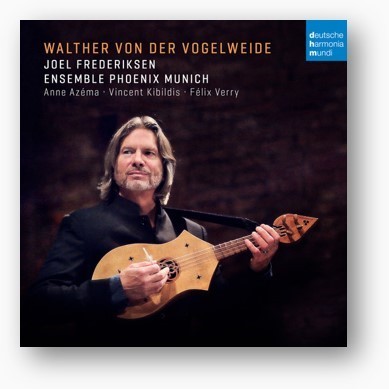
WALTHER VON DER VOGELWEIDE
Una colección de canciones medievales de los minnesänger (juglares) alemanes. Ya disponible.
Consíguelo AQUÍ
Fue el más importante letrista y juglar en lengua alemana de la Edad Media - Walther von der Vogelweide (c. 1100- c. 1147). Pero su legado musical es tan desconocido como su biografía. Solo se conservan algunas de sus melodías. Ahora, el cantante de timbre bajo, laudista y director del conjunto estadounidense Joel Frederiksen y su Ensemble Phoenix Munich presentan un álbum entero de canciones de Walther reconstruidas por primera vez. En estrecha colaboración con renombrados musicólogos y expertos en la música de la Edad Media, Frederiksen y sus compañeros han grabado 17 canciones que ofrecen una fascinante visión de la música vocal de la Edad Media.
Se pueden escuchar canciones de Walther, pero también muchas chansons de trovadores franceses como Jaufré Rudel (c. 1100 - c. 1147), cuyas melodías el juglar probablemente adoptó y adaptó para sus propias canciones. “Cantados y musicados, nos acercamos así mucho más a los textos potentes y sensibles de este artista de lo que lo haríamos si solo los leyéramos", afirma Joel Frederiksen. "Y al hacerlo, nos sumergimos en un mundo primitivo que, después de todo, no parece tan alejado del nuestro".
Con su álbum "Walther von der Vogelweide", Joel Frederiksen vuelve a dedicarse a un gran bardo con su singular voz de timbre bajo. Frederiksen ya había grabado canciones del compositor renacentista John Dowland y del cantante pop Nick Drake para su exitoso álbum "Requiem for a Pink Moon" en 2012. Y acaba de publicar un homenaje a un trovador moderno, el gran cantautor Leonard Cohen, "A Day with Suzanne".
En su décimo álbum, Joel Frederiksen y sus músicos Vincent Kibildis y Félix Verry se acompañan de instrumentos que podrían haber sido tocados por el propio Walther. Entre ellos, la cítola medieval, así como el arpa y el violín. En sus canciones, Walther exhortaba provocativamente a reyes y papas a actuar con honorabilidad.
Al mismo tiempo, formuló un nuevo ideal de Minne en su Minnelyrik y puso patas arriba la etiqueta cortesana que se había alabado hasta entonces.
De ello hablan también las canciones reconstruidas, para las que Walther bien pudo inspirarse en melodías de sus colegas trovadores franceses. Para subrayar esta conexión entre el repertorio de los trouvéres y trovadores y el de los minnesingers, Frederiksen pudo contar con la famosa experta medieval y soprano Anne Azéma. Su participación en esta grabación añade color y profundiza en la comprensión de las fuentes de las canciones de Walther.
A pesar de lo apasionante y singular que ha resultado ser este viaje musical a la Edad Media, Joel Frederiksen dota a las canciones del alto alemán medieval de una intensidad luminosa y una belleza que atraen a los oyentes del siglo XXI.
SOBRE LOS ARTISTAS
Joel Frederiksen
El cantante de timbre bajo y laudista Joel Frederiksen vive en Múnich, Alemania. Su versátil voz de bajo-profundo y sus expresivas interpretaciones le han valido la aclamación mundial. Joel Frederiksen ha dedicado muchos años a su especialidad, el canto para laúd autoacompañado. Su grabación "Réquiem por una luna rosa" recibió el premio Echo alemán en 2013. Actúa con figuras destacadas de la música antigua, como Dame Emma Kirkby, Andrew Parrott, Rubén Dubrovsky y Jordi Savall, y con destacados conjuntos como la Netherlands Bach Society, la Freiburger Baroque Orchestra, el Bach Consort Wien, el Ensemble Gilles Binchois y el Huelgas Ensemble. Frederiksen sigue actuando como artista invitado por toda Europa y Estados Unidos.
Ensemble Phoenix Munich
Ensemble Phoenix Munich (EPM) fue creado en 2003 por Joel Frederiksen, especialista en música antigua, tras trasladarse a Múnich (Alemania). Desde 2007, el grupo ha presentado una serie de conciertos en Múnich, en el Museo Nacional de Baviera, y ha actuado en los principales festivales internacionales.
La programación de EPM refleja la amplia experiencia y los intereses de su fundador y director, Joel Frederiksen, que presenta música desde el Renacimiento y el Barroco europeos (1500-1650) hasta la América primitiva (1640-1860). El conjunto también ha encargado nuevas obras a compositores contemporáneos.
El director artístico Joel Frederiksen se centra en una programación innovadora y original basada en una cuidadosa investigación. El conjunto interpreta regularmente a partir de copias originales, utiliza instrumentos históricos y afinaciones adecuadas al país y a la época, y se adhiere en la medida de lo posible a la investigación reciente en todos los aspectos de la interpretación. Al mismo tiempo, el objetivo último de la interpretación es la comunicación significativa con el público. Los programas del Ensemble Phoenix Munich son atractivos y pretenden, según dice la expresión barroca, conmover los “afectos” de los oyentes.
0 notes
Text
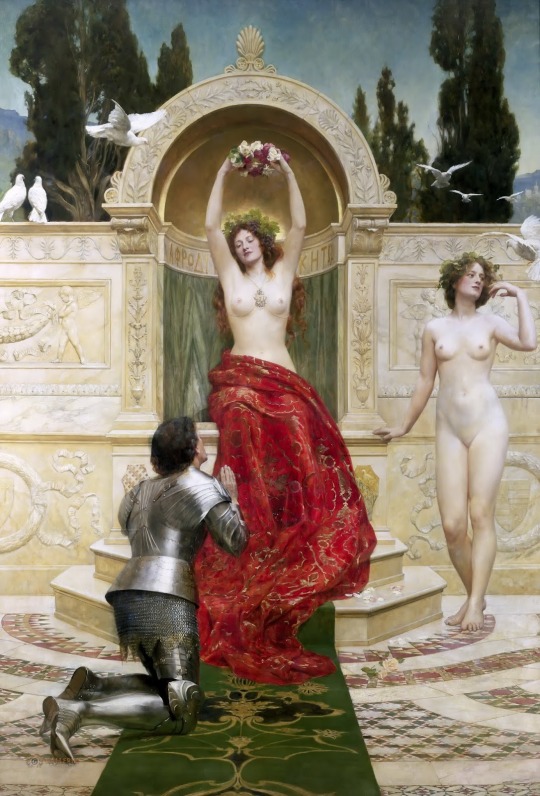
Tannhäuser in the Venusberg by John Collier 1901. Height: 243 cm (95.6 in); Width: 168 cm (66.1 in). Atkinson Art Gallery and Library.
"Then I sank down, crushed and in despair,
my senses left me. When I awoke,
night had fallen on the empty square,
but from afar sounded joyful hymns of praise.
The sweet songs sickened me:
from the lying sounds of promise
which pierced my soul with icy chill,
horror drove me forth in wild flight.
It drove me here, where once I so enjoyed
bliss and pleasure on her warm breast!
To you, fair Venus, I return,
to the sweet darkness of your spell;
I will come down to your court,
where your charms now shall ever smile on me!"
-Richard Wagner, Tannhäuser and the Minnesingers' Contest at Wartburg
https://paganimagevault.blogspot.com/2020/05/tannhauser-in-venusberg-by-john-collier.html
#venus#aphrodite#pagan#europe#european art#paganism#classic art#freyja#20th century art#richard wagner#art#teutonic order#paintings#knight#theatre#theater#tannhäuser#john collier
213 notes
·
View notes
Quote
McCartney is a musical story-teller. He is not an intellectual, an ideologue, a guru, or a rebel. Nor is he a mystic. He has no secret to impart, no Truth - unless it be that it is good to sing and good to love. He is a narrator of tales, an evoker of moods, for celebration and lamentation, and as such he belongs in a very honourable tradition: ancient shamans and weavers of spells; the chansons de geste of mediaeval European minstrelsy; the stylised storycraft of the Scottish seanchaidh (Irish seancaithe) and Welsh bards; minnesingers and meistersingers; 18th-century jobbing composers writing oratorios for courtly patrons; composers of romantic opera; the masters of the tone poem and the film score; and the professional tunesmiths of Tin Pan Alley and the Brill Building. All of it, the folkish and the gentrified, the sacred and the profane, is in his blood. It is almost physiological. Prick him, and a song wells up.
Truant Boy by Martin Shough
#paul mccartney#the danger of being very enthusiastic#kat reads truant boy#'prick him and a song wells up' is very fucking good
36 notes
·
View notes